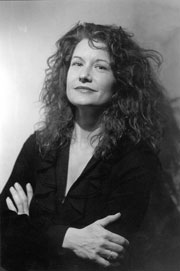By Davida Singer
After channeling Liza Minnelli at the Fez in “Make Love”, a music and monologue tribute to the unsinkable diva and the spirit of New York, whom will Karen Finley take on next? All of us, it seems – – one by one, and by appointment only — when the feisty visual/performance artist returns to The Kitchen this fall, for the first time in 11 years, with her latest creation, “Psychic Portraits” and “Séance: Unsolved Mysteries of the Art World.”
One of the “NEA Four,” who had their National Endowment for the Arts grants revoked in 1990 for “inappropriate” content, Finley’s known as much for social sass and savvy as for artistic scope and ingenuity. Shows like “The Constant State of Desire,” “A Certain Level of Denial,” “The Return of the Chocolate-Smeared Woman,” have been kicking up dirt for over twenty years.
She’s had numerous visual works in galleries on both coasts and internationally, and there have been multi-media events — from “Memento Mori”, about the grieving rituals for those who died of AIDS, to “Go Figure/Fear of Offending, “ complete with an audience participation website. Finley has also made dance records and authored books – – most recently, Pooh Unplugged (1999) and A Different Kind of Intimacy: The Collected Writings of Karen Finley (2000).
And now this new project, “Psychic Portraits,” about which Finley is quite animated, even after a bout with the flu, describing her work as “very specific,” internal profiles of people.
“It’s highly intuitive,” she says, “but what I’m doing here isn’t prophesy or fortune telling. I feel like a vessel. It’s different than the talent I went to the Supreme Court for, but I can pick up problems in psyches.”
DS: What possessed you to explore the trance world?
KF: Much of my early performance work was trance induced. I often spoke in other voices, so I didn’t really rehearse. The performance was ritual in a sense-the-phenomenon-of-an-altered-state – – and the work had a channeled aspect.
Also, I have a strong dream world from my family life. I’m part gypsy, and was brought up with a seer. My mother was also part American Indian and Jewish. She did divination, so omens, cards, spirits were part of growing up, and there were always herbs and medicinal healing. Big dreams were discussed. They were as important as someone getting a job. It was a different way of seeing things from the Western material world. I consider myself a medium. I was actually a practicing psychic into my 20’s when I went into performance. And I’ve also studied Jung.
DS: What happens in the portrait sittings?
KF: People sit in front of me, but I don’t want them talking to me. I just go. I start with an image I see, then words come to me and I start writing, so it becomes image with words on paper. The paper is 8 1/2 by 11-the material is gouache or iridescent. The image is where the person is at this time. Then I’ll interpret, make associations from the image and the person’s energy, but I don’t remember it later.
DS: How many of these have you already done?
KF: So far, I’ve done about 100. Some in Boulder, in San Diego, in Austin, and here, for the Philip Glass Foundation Benefit.
DS: Is there a reason for this type of work now?
KF: I’ve had some phenomenon after people I knew passed away, and I was thinking about portraiture. How it’s been disappointing to me in the art world. Much of it has lost a sense of the healing arts for the audience. When I go by galleries, I’ve been thinking of the social portraits of Sergeant. Now lay people think of 42nd St. portraits as art – at prohibitive prices! We need more art in the world, so I decided to give people portraits with a conceptual aspect and healing arts. I’m better able now to interpret things from life experience. It’s happened from falling from grace, made me more in tune. I think people trust me when I do this, and feel the information is safe with me. I like the price and would like to keep it, but the paper is very expensive.
DS: What about the special “Séance” evening?
KF: It’s a one-night only performance. I’m going to put a camera on it. There will be questions to the audience, and I’m going to be asking questions of certain art personalities who’ve passed. I’ll ask specific things, but when I channel someone sometimes it’s weak. They get tired – – it’s a lot of energy. There’s also a gallery installation of the people I draw. The drawings look lovely and delicate.
DS: What would you like people to take home besides their portraits?
KF: A sense of caring, and that there’s a natural order – – some sense of relief for the person. In these horrible political times, we don’t have a sense of peace or connection.
It’s a high to feel your life has a meaning and an imprint. I decided with this, I’m not going to question it — where the intuitive comes from — and the imagination and inspiration. I think they’re all the same. I’ve decided to accept the generosity of the gods and go with it. Hopefully, it can make life just a little bit easier.
DS: Have you done a self-portrait?
KF: Not yet, but maybe I would. Yes, that’s nice. Or maybe of people who aren’t necessarily there, like Myrna Loy.




































